The labor market is an inversion of the goods and services market: in the labor market, individual buyers from the goods and services market become the suppliers of labor, while the firms that sold goods in the goods and services market become the buyers. Firms need workers to produce and sell goods, and so after they have decided how many workers and how many hours of labor they want (a process which we will examine in the labor demand unit ), they enter the labor market and "buy" labor. Workers enter the labor market with an idea of how much they want to work and how much they want to be paid, and they "supply" the labor. The combination of the two, labor supply and labor demand, determines how the labor market behaves. Let's take a look at labor supply.
Workers, when deciding whether or not they want to work, and how much they want to work, are faced with a choice between two possibilities: leisure and consumption. (Economists assume that leisure can be treated as a normal good: more is better) There is a tradeoff, however, between leisure and consumption). If a person decides that they want leisure, then they will work less (or not at all), but this means that they won't be able to buy as many things. If they decide that they want to consume, then they will work more (or all of the time), but this means that they won't have as much free time to themselves. Their preferences for leisure (free time) and all other goods (consumption), combined with the current market wage, will determine what combination of leisure and all other goods they will choose, much in the same way that an individual's indifference curves and the market price of different goods will determine what combination of goods that individual will buy. Even though workers are the suppliers of labor, they make their working decisions in a manner similar to the way they make their buying decisions: based on preferences and price.
Recall that when buyers in a goods and services market are making decisions, we can model their decision-making behavior through a combination of their indifference curves and their budget constraints. Since the decision to work or not to work is made in a similar fashion, we can do the same thing for labor supply. Workers will try and maximize their utility based on their preferences between having free time and having money, and on their budget constraint (how much of each good: leisure or all other goods, that they can afford).
How do we represent a budget constraint for leisure and all other goods (AOG)?
Typically, leisure is measured in one hour units, so that in one day, a worker
can choose to take up to 24 hours of leisure. All other goods (AOG) are
measured by their dollar value, so that a worker can choose to work 24 hours a
day and buy up to 24 hours times the wage (24w) worth of all other goods.
Graphically, a budget constraint would look like this:
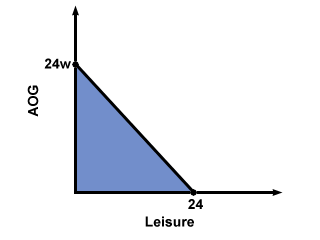
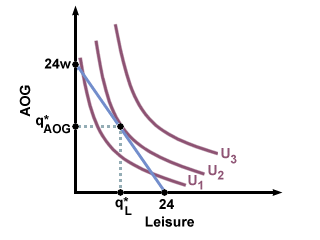
Just as a buyer's budget constraint pivots with a change in the price of one good, a worker's budget constraint can pivot with a change in the wage. If the wage increases, the curve pivots outwards (U3). If the wage drops, then the curve pivots inwards (U1). Note that the maximum leisure point is fixed, since there are only 24 hours in a day.
In the graph below, you can see the inwards pivot that occurs
when the wage level drops: workers cannot afford as many other goods as they
could prior to the
drop in pay.
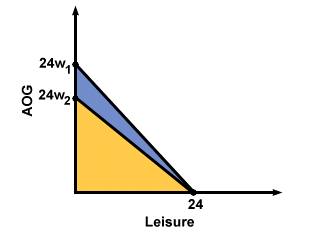
The substitution effect and the income effect, which we have seen before in the SparkNote covering supply and demand, also influence worker's decisions between consumption and leisure.
When the wage increases, the income effect makes workers feel wealthier and
therefore makes them want more of both leisure and consumption. The
substitution effect, however, makes leisure relatively expensive (since the
worker would have to give up more wages to have free time; think of the wages
lost as the price of leisure), so workers will want more consumption and less
leisure. Because labor is inversely related to leisure, this means that an
increase in wages will cause labor to both increase (substitution effect) and
decrease (income effect). Therefore, when wages increase, the combined effect
of the substitution and income effect is that workers will choose more
consumption; the effect on the level of labor and leisure is uncertain. If we
assume that the substitution effect is stronger, then workers will choose to
work more and play less, which makes sense, since a higher wage would give
workers more incentive to work.
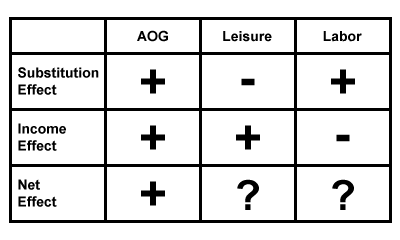
Is this always true, that the substitution effect outweighs the income effect?
Some economists believe that it is initially true, at relatively low wage
levels. However, as the wage gets progressively higher, they believe that the
income effect begins to outweigh the substitution effect, and very high
wage-earners will begin to choose leisure over consumption even if their wage
increases. (Maybe that's why corporate bigwigs have the reputation of having
too much free time to gallivant around on tropical islands).
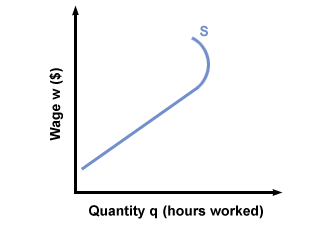
An individual's labor supply curve marks out the number of hours they are willing to work at different wages, the same way that a seller's supply curve marks out how much they are willing to sell at different prices. How do we find the aggregate labor supply curve? To find aggregate labor supply from many individual supply curves, use horizontal addition to combine all of the work that workers are willing to perform at each wage level, and form the new aggregate labor supply curve. (If you don't remember how to do this, you can refresh your memory by going back to the section on horizontal addition in the Supply and Demand SparkNote).













